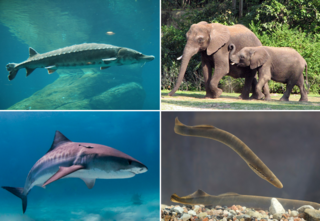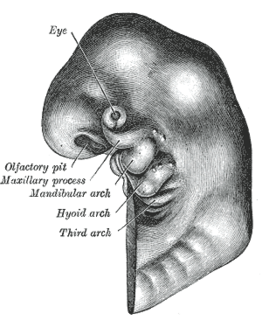Related Research Articles

A chordate is an animal of the phylum Chordata. All chordates possess 5 synapomorphies, or primary characteristics, at some point during their larval or adulthood stages that distinguish them from all other taxa. These 5 synapomorphies include a notochord, dorsal hollow nerve cord, endostyle or thyroid, pharyngeal slits, and a post-anal tail. The name “chordate” comes from the first of these synapomorphies, the notochord, which plays a significant role in chordate structure and movement. Chordates are also bilaterally symmetric, have a coelom, possess a circulatory system, and exhibit metameric segmentation.

Vertebrates comprise all species of animals within the subphylum Vertebrata, including all mammals, birds, reptiles, amphibians, and fish. Vertebrates represent the overwhelming majority of the phylum Chordata, with currently about 69,963 species described. Vertebrates comprise such groups as the following:

The mesoderm is the middle layer of the three germ layers that develop during gastrulation in the very early development of the embryo of most animals. The outer layer is the ectoderm, and the inner layer is the endoderm.
Myllokunmingia is a genus of basal chordate from the Lower Cambrian Maotianshan shales of China, thought to be a vertebrate, although this is not conclusively proven. It is 28 mm long and 6 mm high.

A tunicate is a marine invertebrate animal, a member of the subphylum Tunicata. It is part of the Chordata, a phylum which includes all animals with dorsal nerve cords and notochords. The subphylum was at one time called Urochordata, and the term urochordates is still sometimes used for these animals. They are the only chordates that have lost their myomeric segmentation, with the possible exception of the 'seriation of the gill slits'.

In anatomy, the notochord is a flexible rod formed of a material similar to cartilage. If a species has a notochord at any stage of its life cycle, it is, by definition, a chordate. The notochord lies along the anteroposterior axis, is usually closer to the dorsal than the ventral surface of the embryo, and is composed of cells derived from the mesoderm.

Pikaia gracilens is an extinct, primitive chordate animal known from the Middle Cambrian Burgess Shale of British Columbia. Sixteen specimens are known from the Greater Phyllopod bed, where they comprised 0.03% of the community. It resembled the lancelet and perhaps swam much like an eel.

Larvaceans, Class Appendicularia are solitary, free-swimming tunicates found throughout the world's oceans. Like most tunicates, larvaceans are filter feeders. Unlike most other tunicates, they live in the pelagic zone, specifically in the photic zone, or sometimes deeper. They are transparent planktonic animals, generally less than 1 cm (0.39 in) in body length, excluding the tail.

Ascidiacea, commonly known as the ascidians, tunicates, and sea squirts, is a polyphyletic class in the subphylum Tunicata of sac-like marine invertebrate filter feeders. Ascidians are characterized by a tough outer "tunic" made of a polysaccharide.

A cephalochordate is an animal in the chordate subphylum, Cephalochordata. They are commonly called lancelets. Cephalochordates possess 5 synapomorphies, or primary characteristics, that all chordates have at some point during their larval or adulthood stages. These 5 synapomorphies include a notochord, dorsal hollow nerve cord, endostyle, pharyngeal slits, and a post-anal tail. The fine structure of the cephalochordate notochord is best known for the Bahamas lancelet, Asymmetron lucayanum. Cephalochordates are represented in modern oceans by the Amphioxiformes and are commonly found in warm temperate and tropical seas worldwide. With the presence of a notochord, adult amphioxus are able to swim and tolerate the tides of coastal environments, but they are most likely to be found within the sediment of these communities.

The lancelets, also known as amphioxi, consist of some 30 to 35 species of "fish-like" benthic filter feeding chordates in the order Amphioxiformes. They are the modern representatives of the subphylum Cephalochordata. Lancelets closely resemble 530-million-year-old Pikaia, fossils of which are known from the Burgess Shale. Zoologists are interested in them because they provide evolutionary insight into the origins of vertebrates. Lancelets contain many organs and organ systems that are closely related to those of modern fish, but in more primitive form. Therefore, they provide a number of examples of possible evolutionary exaptation. For example, the gill-slits of lancelets are used for feeding only, and not for respiration. The circulatory system carries food throughout their body, but does not have red blood cells or hemoglobin for transporting oxygen. Lancelet genomes hold clues about the early evolution of vertebrates: by comparing genes from lancelets with the same genes in vertebrates, changes in gene expression, function and number as vertebrates evolved can be discovered. The genome of a few species in the genus Branchiostoma have been sequenced: B. floridae,B. belcheri, and B. lanceolatum.

Balanoglossus is an ocean-dwelling acorn worm (Enteropneusta) genus of great zoological interest because, being a Hemichordate, it is an "evolutionary link" between invertebrates and vertebrates. Balanoglossus is a deuterostome, and resembles the Ascidians or sea squirts, in that it possesses branchial openings, or "gill slits". It has a notochord in the upper part of the body and has no nerve chord. It does have a stomochord, however, which is gut chord within the collar. Their heads may be as small as per 2.5 mm (1/10 in) or as large as 5 mm (1/5 in).

The acorn worms or Enteropneusta are a hemichordate class of invertebrates consisting of one order of the same name. The closest non-hemichordate relatives of the Enteropneusta are the echinoderms. There are 111 known species of acorn worm in the world, the main species for research being Saccoglossus kowalevskii. Two families—Harrimaniidae and Ptychoderidae—separated at least 370 million years ago.
The dorsal nerve cord is a unique feature to chordates, and it is mainly found in the Vertebrata chordate subphylum. The dorsal nerve cord is only one embryonic feature unique to all chordates, among the other four chordate features-- a notochord, a post-anal tail, an endostyle, and pharyngeal slits. The dorsal hollow nerve cord is a hollow cord dorsal to the notochord. It is formed from a part of the ectoderm that rolls, forming the hollow tube. This is important, as it distinguishes chordates from other animal phyla, such as Annelids and Arthropods, which have solid, ventral tubes. The process by which this is performed is called invagination. The cells essentially convolute into the body cavity, arranging themselves on the dorsal plane above the notochord, as mentioned above. The evolutionary explanation to this adaptation from a solid cord to hollow tube is unknown. In vertebrates, the dorsal nerve cord is modified into the central nervous system, which comprises the brain and spinal cord.

The pharyngeal arches, also known as visceral arches, are structures seen in the embryonic development of vertebrates that are recognisable precursors for many structures. In fish, the arches are known as the branchial arches, or gill arches.
The pharyngula is a stage in the embryonic development of vertebrates. At this stage, the embryos of all vertebrates are similar, having developed features typical of vertebrates, such as the beginning of a spinal cord. Named by William Ballard, the pharyngula stage follows the blastula, gastrula and neurula stages.

The pharynx is the part of the throat behind the mouth and nasal cavity, and above the oesophagus and trachea. It is found in vertebrates and invertebrates, though its structure varies across species. The pharynx carries food and air to the esophagus and larynx respectively. The flap of cartilage called the epiglottis stops food from entering the larynx.
The stomochord is a flexible, hollow tube found in hemichordates. Stomochords arise in embryonic development as an outpocketing from the roof of the embryonic gut anterior to the pharynx. In adults, they extend dorsally from the pharynx into the proboscis, and it communicates with the oral cavity. Their walls are composed primarily of epithelial cells, including ciliated and glandular cells.

The vertebral column, also known as the backbone or spine, is part of the axial skeleton. The vertebral column is the defining characteristic of a vertebrate in which the notochord found in all chordates has been replaced by a segmented series of bone: vertebrae separated by intervertebral discs. Individual vertebrae are named according to their region and position, and can be used as anatomical landmarks in order to guide procedures such as lumbar punctures. The vertebral column houses the spinal canal, a cavity that encloses and protects the spinal cord.
Xbra is a homologue of Brachyury (T) gene for Xenopus. It is a transcription activator involved in vertebrate gastrulation which controls posterior mesoderm patterning and notochord differentiation by activating transcription of genes expressed throughout mesoderm. The effects of Xbra is concentration dependent where concentration gradient controls the development of specific types of mesoderm in Xenopus. Xbra results of the expression of the FGF transcription factor, synthesized by the ventral endoderm. So while ventral mesoderm is characterized by a high concentration of FGF and Xbra, the dorsal mesoderm is characterized by a reunion of two others transcription factors, Siamois and XnR, which activates the synthesis of Goosecoid Transcription Factor. Goosecoid enables the depletion of Xbra. In a nutshell, high concentrations of Xbra induce ventral mesoderm while low concentration stimulates the formation of a back.
References
- ↑ Hyman, L.H.; Wake, M.H. (1992). Hyman's Comparative Vertebrate Anatomy. University of Chicago Press. p. 71. ISBN 9780226870137 . Retrieved 2014-12-13.
- ↑ O. Cleaver, D. W. Seufert and P. A. Krieg (25 January 2000). "Endoderm patterning by the notochord: development of the hypochord in Xenopus" (PDF). Development. 127 (4): 869–879. PMID 10648245 . Retrieved 2014-12-13.